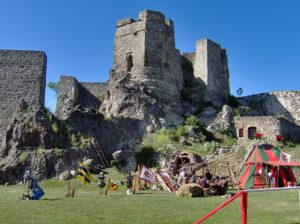Photo: Pudelek
Léva (Levice, Lewenz) was a Hungarian castle of the famous Lord Thury György and it is located in the Upper lands/Horná Zem/Felvidék, in Slovakia. It is in the valley of the Garam River, just 34 km from Selmecbánya (Banská Štiavnica, Schemnitz). You can read a legend about the white geese of Léva Castle on my page:

Here is a nice film about it, unfortunately only in the Hungarian language:
https://www.youtube.com/watch?v=E0V7MVuIbho
The castle was first mentioned in 1347 as “Leua”. The castle was built above a strong Celtic fort. It is also said to have been an important center of the Hunnish Empire of King Attila in the 5th century A.D. There are the remains of a 12th-century castle and a church on a hill called Baratka, next to the city.

Léva used to be a royal castle, owned by the Hungarian king. It was built in the 13th century. King Ottokár II was trying to take it by siege in 1270 but he couldn’t. Later it went to Csák Máté and the king could take it back only in 1321 when it became Bars County’s administrative center.
The castle witnessed how King Károly Róbert was beheading Sebe, the daughter of Felicián Zách. (The noble who had tried to assassinate him and injured his queen.) This frontier castle was heroically defended in 1544 by Balassa Menyhért against the Turks but the captain was accused of treason and escaped to Transylvania. You can read more about Lord Balassa here:

Its other famous captain had been the legendary Thury György, the duelist, and in 1560 it was held by Dobó István, the hero of Eger Castle. Dobó had a palace built under the castle.

Prince Bocskai István of Transylvania laid a siege on the castle but could not take it so he burnt the city in 1605. Prince Bethlen proved to be more successful and took it during his campaign. The castle opened its gate to the huge Ottoman army appearing in front of it in 1663.

The Battle at Léva on 19 July, 1664
General Jean-Louis Radouit de Souches, commander of the imperial troops north of the Danube, largely nullified the results of the previous year’s victorious Turkish campaign with his attack in the spring of 1664. He recaptured Nyitra, defeated the Pasha of Várad at Zsarnóca, and took Léva in mid-June. The latter loss, however, the Porte could not afford. The grand vizier, Köprülü Fazil Ahmed, commissioned the new-appointed governor of Érsekújvár, Ali Pasha, to retake Léva. The armies of the Buda and Eger vilayets and the Moldavian Voivode Ghica were gathered in the camp at Esztergom. The Ottoman army of some 25-30,000 men began the siege of Léva in early July, with the Crimean Tartars ravaging the surrounding countryside.


The imperial army was camped near the Garam River, and the raiders were sent out to spy on the Turkish army. Early the next day, 19 July, the camp was awakened by an unexpected alarm. On the far bank, the plants stirred by the breeze gave the impression of the enemy moving towards the river. Souches had his army in battle formation, but as it cleared, the reason for the movement became clear.

The Major General, however, did not want to see his army’s fighting spirit wane, so he decided to attack by crossing the river. However, there was no bridge available for the infantry, so he ordered each cavalryman to take one infantryman on his horse. Thus, in two hours, the entire army was moved across the Garam.

As the imperial troops crossed the river, the Turkish army began to descend from the high ground towards the river. The Pasha aimed to better spread his larger army to encircle the Imperials. Koháry attacked on the right flank but was outnumbered and retreated. When he received reinforcements, he repeated the attack and beat back the Spahis and Janissaries. However, he was hit by a Janissary bullet and fell dead from his horse.

While in the north, on the emperor’s left flank and in the center, the battle was essentially at a standstill, as the Turks did not attack much and the activity of Balassa’s hussars on the left flank warned them to be cautious, in the south, the pasha unleashed a huge offensive force. Heister repulsed the Turks, but his advance was halted by the Pasha’s deployment of new troops. Heister retreated but received reinforcements from de Souches before renewing his attack. The pasha then deployed fresh Walachian and Tatar units here. Recognizing the disastrous situation, the major general withdrew troops from the left flank and sent them to Heister.

However, the fighting on the Imperial right flank continued with varying degrees of success, and only slowly did the Imperials manage to gain the upper hand. To make matters worse, the Turkish main army also launched an attack, which General Knigge struggled to repel. On the right flank, Heister won the day with the help of Caprara, who arrived here, and while the Wallachian and Tartar troops retreated, the rest of the troops were slowly withdrawn by the Pasha to the heights between Léva and Podluzsány.


The town suffered beyond imagination
Léva was taken and retaken periodically, in 1678 and 1685 by the rebel aristocrat Prince Thököly Imre. It had changed hands three more times during the War of Independence of Prince Rákóczi Ferenc’s struggles in the early 18th century and was finally utterly destroyed by General Heister in 1709.

The point is that its town had suffered beyond imagination. There is a beautiful exhibition inside it now.

Dear Readers, I can only make this content available through small donations or by selling my books or T-shirts:
Please, feel free to support me with a coffee here:
You can check out my books on Amazon or Draft2Digital, they are available in hardcover, paperback, or ebook:
https://www.amazon.com/dp/198020490X or at https://books2read.com/b/boYd81

My work can also be followed and supported on Patreon: Become a Patron!http://Become a Patron!

































































